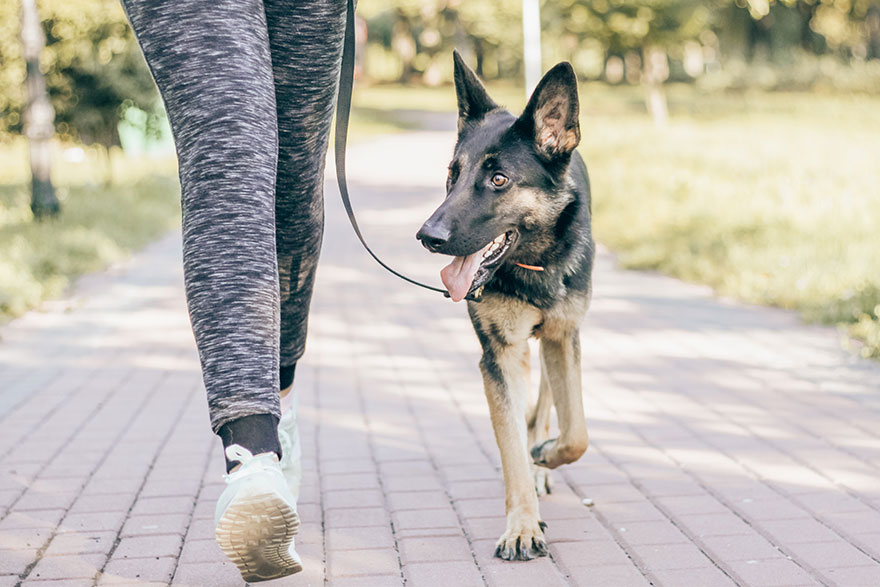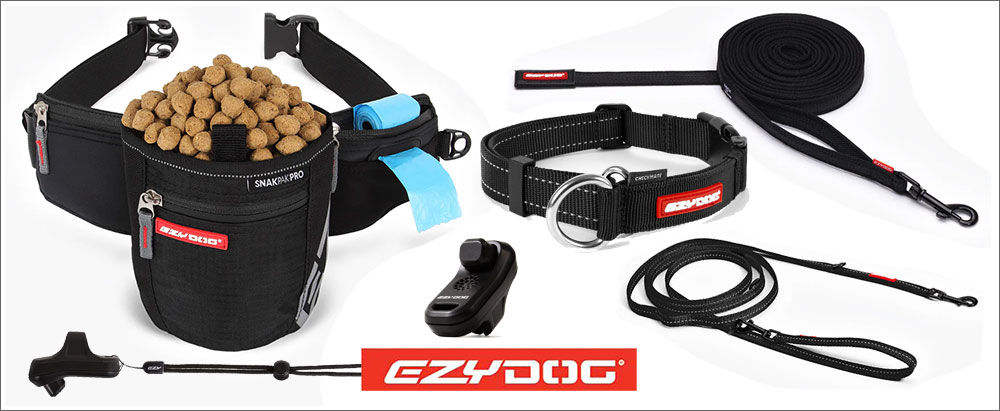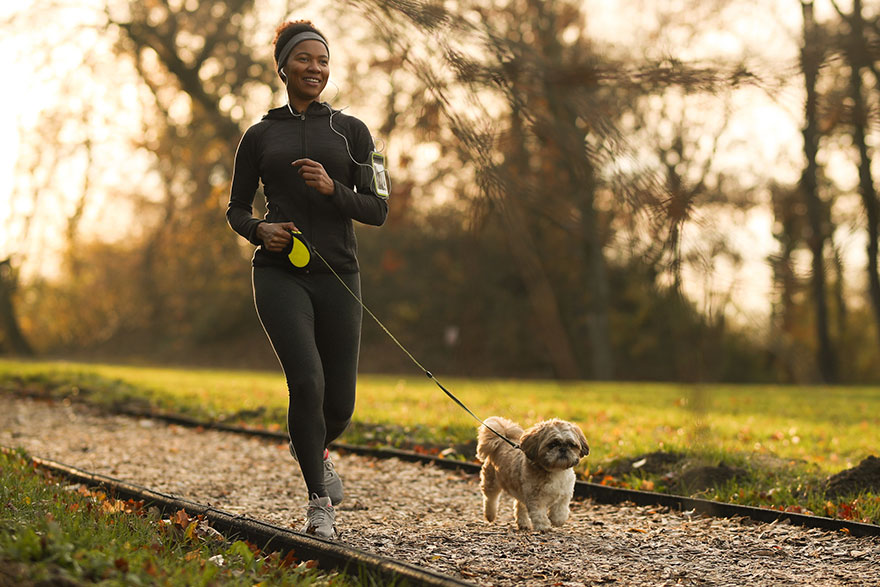
Heel Command (Dog Training Command 7)
- Share
- Share
- Share
- Share
How to Teach Your Dog to Walk Beside You Using The ‘Heel Command’.
Now that you can get your dog’s attention by calling his/her name, and you have all the ‘Basic’ dog training commands under your belt, it’s time to add one of the most useful, practical and when executed well by your beloved fur baby, one of the most pleasurable actions they can perform with you, and that’s to walk obediently by your side.
Having complete control of your dog is a dog owners’ responsibility, especially when out together in a public place, but communicating with your four-legged companion, so they understand what you want from them is also how you build a strong bond. Walking a dog, calmly beside you, in a ‘lose leash manner’ is one of the joys of pet ownership and for many people, one of the reasons they give for buying a dog in the first place. The dog’s the excuse to get outside and exercise.
This dog obedience training article will teach you how to train your dog to walk beside you, and at the same pace, using the ‘Heel Command‘ by applying positive reinforcement training techniques.
The following list is what we recommend you have handy for this dog training command session:
- Small sized, soft treats that are very tempting
- Clicker
- Collar
- Training Leash, 5-10 Metres (16-32 Foot)
- Small quiet space with no distractions
If you don’t have, or prefer not to use a ‘clicker’, you can substitute it by using the word ‘yes’.

Dog training essentials available from Ezydog Australia
Steps to Teaching the ‘Heel Command’
Before we dive in, it’s worth noting or clarifying what we’d like from our dog after using this instruction.
Essentially, we want our dog to walk calmly, close to our left-hand side and at the same pace we’re walking, without pulling on the lead and without stopping to sniff every plant he/she passes along the way.
If that sounds like heaven to you, read on to find out how to achieve this with just 4 simple steps.
When teaching this dog training command, I’m going to assume you’ve already taught your dog to respond to his/her name and your dog’s compliant with sit and stand. If not, you’ll find instructions for these contained in the article ‘List of Dog Training Commands‘.
1/ In a quiet hallway inside attach your longer training leash and grab a handful of treats.
The first step in training the heel command is to get your dog’s attention by saying his/her name. You’ll want to ‘mark’ moments when your dog naturally focuses on you, looking into your eyes, rewarding them with treats, verbal praise and using ‘yes’, or a click if you’re using a clicker.
Stand in front of your leashed dog and click or praise, then treat when they make eye contact. Gradually transition to treating only when they stand by your side, setting the foundation for the crucial heel position.
I suggest ‘starting inside’ because there are less distractions, allowing your dog to concentrate on you as you walk up and down a hallway. Outdoor noises and smells are intriguing to an inquisitive pup, even to an older dog, new to that environment.
2/ The next step in teaching your dog to heel involves introducing ‘hand targeting‘ at your side. Remember, the correct position for heeling is when a dog is walking in line with your legs and their body is parallel to your direction of movement.
While your dog is leashed (hold the leash with your right hand) and positioned at your side, take one or two steps and present your left-hand with the treat for targeting. Ensure it’s easily visible and accessible to your dog, then praise and treat when they touch it with their nose.
If your dog’s head gets ahead of your legs or they don’t respond, try adding a treat to your closed hand instead. Once your pooch takes interest in your hand and follows it as you walk forward, reward with the treat and go again. Eventually, your dog won’t need the treat and will start to follow just your hand.
Tip: As you continue to practice, try to keep your hand as close to your body as possible so your hand is at your left hip. You want your dog to be right next to you.
3/ Next, you’ll want to gradually extend the distance you walk before offering your hand for a target. Try increments of 5 as you concentrate on maintaining their attention. If your dog veers off to investigate something or gets distracted, stop, until they refocus on you.
Always praise, click or say ‘yes’ and treat when they look up at you, take a few steps, and reward again as they return to the ‘heel position’. To reinforce walking in the heel position, give the reward while your dog is in motion.
4/ Finally, encourage your dog to walk in the heel position without relying heavily on the hand target. Use it for specific situations, mainly to redirect attention or when crossing a street. You can now start to reduce the frequency of rewarding with treats to once every few minutes.
Note: Expecting your dog to heel for the entire walk is just not realistic. Focus on reinforcing the desired behaviour periodically, to keep walks enjoyable for you and your pooch, but stopping for a toilet break or sniffing a tree is normal and healthy dog behaviour too.

It’s a good idea to mix up the pace during ‘walkies’ too. Change your speed from a casual stroll to a quick, high cardio paced walk and everything in between.
Summary of Teaching Your Dog The ‘Heel Command’
Remember consistency, practice and patience are the keys with all dog training. Some dogs, such as Beagles are more difficult to teach than others, because they love to sniff and follow their nose.
Some dogs that aren’t overly motivated by food treats (rare) will almost certainly take to cooked chicken pieces. However, I would strongly suggest finding a commercial option that works because apart from the expense, chicken is messy and doesn’t last very long out of a sealed container in the fridge. There are many brands and flavours to choose from these days, and many are made with healthy natural ingredients. I would also suggest using and rotating several different types, so your dog doesn’t become used to just one.
As I mentioned above, using a training leash of between 5-10 metres is ideal. These leashes are used extensively for ‘track and trace’ dog training disciplines so are readily available.
Most pet shops, which you can find near you, listed on Pet Directory will have these in stock.
It’s worth noting that the longer leash isn’t to reel your dog in if they ignore you, but to control the situation. As you walk, give your dog some ‘down time’ by saying ‘free’ as a release word, allowing your dog to roam about freely to relieve themselves or have a good sniff, before resuming the heel position.
This command is ideal to use when out for a walk and people with other dogs are approaching, especially smaller dogs if your dog is larger. Being totally focused on you and your instructions is the key to avoiding distractions as you pass people to your right.
Having trouble, or have a question about getting your dog to stroll calmly by your side when commanded?
Leave a comment for ‘Bear’ below and he’ll be happy to answer it for you, especially if you get his attention by using his name.
We at PetsBook also recommend getting out with your dog and join a training course.
Pet Directory has many local dog training businesses listed near you with experienced and accredited dog trainers ready to help you with dog obedience and dog command training.
» List of Dog Training Commands

Hi, I’m Bear, the Training Manager at PetsBook. With over 20 years experience using positive reinforcement dog training techniques, I’m proud to have the opportunity to help you develop a stronger bond with your fur baby, by teaching you useful commands with obedience training.
- Cat Behaviour & Training 1
- Cat Care 1
- Cat Health 1
- Cats 3
- Dog Behaviour & Training 38
- Dog Care 1
- Dog Grooming 2
- Dog Health 1
- Dogs 42
After A Product or Service for Your Pet?
PetsBook's Pet Directory is the easy way to find everything you need to take care of your 'fur baby'.
ABN: 97 675 528 953






